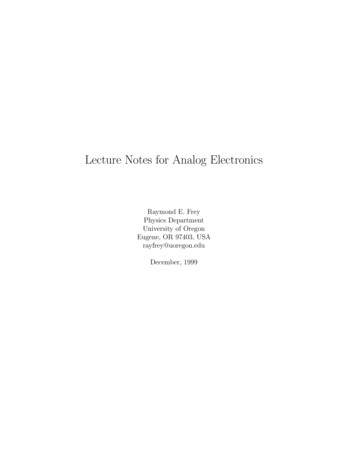
Transcription
EEE1002/EEE1010 - Electronics IAnalogue ElectronicsLecture NotesS. Le GoffSchool of Electrical and Electronic EngineeringNewcastle University
School of EEE @ Newcastle -------------------Module OrganizationLecturer for Analogue Electronics: S Le Goff (module leader)Lecturer for Digital Electronics: N ColemanAnalogue Electronics: 24 hours of lectures and tutorials (12 weeks 2 hours/week)Assessment for analogue electronics: Mid-semester test in November, analogue electronics only, 1 hour, 8% of the final mark. Final examination in January, analogue & digital electronics, 2 hours, 50% of the final mark.Recommended Books: Electronics – A Systems Approach, 4th Edition, by Neil Storey, Pearson Education, 2009. Analysis and Design of Analog Integrated Circuits, 5th Edition, by Paul Gray, Paul Hurst,Stephen Lewis, and Robert Meyer, John Wiley & Sons, 2012. Digital Integrated Circuits – A Design Perspective, 2th Edition, by Jan Rabaey, AnantaChandrakasan, and Borivoje Nikolic, Pearson Education, 2003. Microelectronic Circuits and Devices, 2th Edition, by Mark Horenstein, Prentice Hall, 1996. Electronics Fundamentals – A Systems Approach, by Thomas Floyd and David Buchla,Pearson Education, 2014. Principles of Analog Electronics, by Giovanni Saggio, CRC Press (Taylor & Francis --------------------1EEE1002/EEE1010 – Electronics I – Analogue Electronics
School of EEE @ Newcastle -------------------1. SemiconductorsSolid materials may be divided, with respect to their electrical properties, into three categories:1. ConductorsConductors (e.g., copper, aluminium) have a cloud of free electrons at all temperature aboveabsolute zero. This is formed by the weakly bound “valence” electrons in the outermost orbits oftheir atoms. If an electric field is applied across such a material, electrons will flow, causing anelectric current.2. InsulatorsIn insulating materials, the valence electrons are tightly bound to the nuclei of the atoms and veryfew of them are able to break free to conduct electricity. The application of an electric field doesnot cause a current to flow as there are no mobile charge carriers.3. SemiconductorsAt very low temperatures, semiconductors have the properties of an insulator. However, at highertemperatures, some electrons are free to move and the materials take on the properties of aconductor (albeit a poor one). Nevertheless, semiconductors have some useful characteristicsthat make them distinct from both insulators and conductors.To understand the operation of diodes, transistors, and other electronic devices, we need tounderstand the basic structure of semiconductors.A few common semiconductor materials: silicon (Si), germanium (Ge), gallium arsenide (GaAs),indium phosphide (InP), silicon carbide (SiC), silicon-germanium (SiGe).The first transistors were made from germanium (Ge). Silicon (Si) types currently predominate butcertain advanced microwave and high performance versionsemploy the compoundsemiconductor material gallium arsenide (GaAs) and the semiconductor alloy silicon ------------------------2EEE1002/EEE1010 – Electronics I – Analogue Electronics
School of EEE @ Newcastle -------------------Silicon and germanium fall in column IVa of the Periodic Table. This is the carbon family ofelements. The characteristic of these elements is that each atom has four electrons to share withadjacent atoms.Z6Elementcarbon14 siliconNo. of electrons/shell2, 42, 8, 432 germanium 2, 8, 18, 450 tin2, 8, 18, 18, 482 lead2, 8, 18, 32, 18, 4Let us have a closer look at silicon. The crystal structure of silicon is represented below.SiSiSiCovalent bondSiSiSiSiSiSiElectrons on the outershells of two -------------------------3EEE1002/EEE1010 – Electronics I – Analogue Electronics
School of EEE @ Newcastle -------------------The nature of a bond between two silicon atoms is such that each atom provides one electron toshare with the other. The two electrons thus shared between atoms form a “covalent bond”. Sucha bond is very stable and holds the two atoms together very tightly. It requires a lot of energy tobreak this bond.All of the outer electrons of all silicon atoms are used to make covalent bonds with other atoms.There are no electrons available to move from place to place as an electrical current. Thus, a puresilicon crystal is quite a good insulator. Increasing the temperature results in some electronsbreaking free from their covalent bonds and this improves the conductivity of the silicon crystal.To allow a silicon crystal to conduct electricity without having to increase the temperature, wemust find a way to allow some electrons to move from one place to the other within the crystaldespite the covalent bonds between atoms. One way to accomplish this is to introduce an impuritysuch as arsenic or phosphorus into the crystal structure. Such process is called doping. Theseelements are from column Va of the Periodic Table, and have five outer valence electrons toshare with other atoms.SiSiSiFree electronSiPSiCovalent bondSiSiSiFour of these five electrons bond with adjacent silicon atoms as before, but the fifth electroncannot form a bond and is thus left “alone”. This electron can easily be moved with only a smallapplied electrical voltage. Because the resulting crystal has an excess of current-carryingelectrons, each with a negative charge, it is known as "N-type" ----------------4EEE1002/EEE1010 – Electronics I – Analogue Electronics
School of EEE @ Newcastle -------------------Such construction does not conduct electricity as easily as, say, copper or silver since it doesexhibit some resistance to the flow of electricity. It cannot properly be called a conductor, but atthe same time it is no longer an insulator. Therefore, it is known as a semiconductor.We obtained a semiconductor material by introducing a 5-electron impurity into a matrix of 4electron atoms. We can also do the opposite and introduce a 3-electron impurity into such acrystal. Suppose we introduce some aluminium (from column IIIa in the Periodic Table) into thecrystal. We could also use gallium which is also in column IIIa.These elements only have three valence electrons available to share with other atoms. Thosethree electrons do indeed form covalent bonds with adjacent silicon atoms, but the expectedfourth bond cannot be formed. A complete connection is impossible here, leaving a "hole" in thestructure of the crystal.SiSiSiHoleSiAlSiCovalent bondSiSiSiThere is an empty place where an electron should logically go, and often an electron will try tomove into that space to fill it. However, the electron filling the hole has to leave a covalent bondbehind to fill this empty space, and therefore leaves another hole behind as it moves. Yet anotherelectron may move into that hole, leaving another hole behind, and so on. In this manner, holesappear to move as positive charges through the crystal. Therefore, this type of semiconductormaterial is designated "P-type" silicon.In an N-type semiconductor, the electrons are often referred to as the majority charge carriers,whereas the holes are called the minority charge carriers since they are actually also present -----------5EEE1002/EEE1010 – Electronics I – Analogue Electronics
School of EEE @ Newcastle -------------------at much lower concentration. In a similar way, in a P-type semiconductor, the holes are referred toas the majority charge carriers, whereas the electrons, which are present at much lowerconcentration, are the minority charge carriers.The role played by the minority charge carriers can sometimes be ignored for simplicity -----------------6EEE1002/EEE1010 – Electronics I – Analogue Electronics
School of EEE @ Newcastle -------------------2. The PN Junction (Diode) Basic OperationWe have just seen that a crystal of pure silicon can be turned into a relatively good electricalconductor by adding an impurity such as arsenic or phosphorus (for an N-type semiconductor) oraluminium or gallium (for a P-type semiconductor). By itself, a single type of semiconductormaterial is not very useful. But, something interesting happens when a single semiconductorcrystal contains both P-type and N-type regions.Hereafter, we examine the properties of a single silicon crystal which is half N-type and half Ptype. The two types are shown separated, as if they were two separate crystals being put incontact. In the real world, two such crystals cannot be joined together usefully. Therefore, apractical PN junction can only be created by inserting different impurities into different parts of asingle crystal.Mobile negative charges(free electrons)Mobile positive charges(free holes)P-type siliconN-type silicon-- Bound positive charges -- --- - ----Bound negative chargesWhen we join the N- and P-type crystals together, an interesting interaction occurs around thejunction. The extra electrons in the N region will combine with the extra holes in the P region. Thisleaves an area where there are no mobile charges, known as depletion region, around --------------------7EEE1002/EEE1010 – Electronics I – Analogue Electronics
School of EEE @ Newcastle -------------------JunctionP-type siliconN-type silicon-- - - -----P-type siliconN-type silicon- - -- --- ---Depletion regionSuppose now that we apply a voltage to the outside ends of our PN crystal.Assume first that the positive voltage is applied to the N-type material. In such case, the positivevoltage applied to the N-type material attracts free electrons towards the end of the crystal andaway from the junction, while the negative voltage applied to the P-type end attracts holes awayfrom the junction.VReverse bias0 volt P-type siliconN-type silicon -- - - - -- --The depletion regionbecomes -------------8EEE1002/EEE1010 – Electronics I – Analogue Electronics
School of EEE @ Newcastle -------------------The result is that all available current carriers are attracted further away from the junction, and thedepletion region grows correspondingly larger. Therefore, there is no current flow through thecrystal because no current carriers can cross the junction. This is known as reverse bias appliedto the semiconductor crystal.Assume now that the applied voltage polarities are reversed. The negative voltage applied to theN-type end pushes electrons towards the junction, while the positive voltage at the P-type endpushes holes towards the junction. This has the effect of shrinking the depletion region. 0.7 voltVForward bias0 volt- P-type siliconN-type silicon -- - - -- --The depletion region becomes narrower as Vis increased, until eventually it disappears.Once the applied voltage V has become large enough to make the depletion region completelydisappear, i.e. once the value of V becomes equal to the threshold voltage Vd of the PN junction(Vd 0.7 volt for silicon and Vd 0.3 volt for germanium), current carriers of both types are finallyable to cross the junction into the opposite ends of the crystal. Now, electrons in the P-type endare attracted to the positive applied voltage, while holes in the N-type end are attracted to thenegative applied voltage. This is the condition of forward bias.The conclusion is that an electrical current can flow through the junction in the forward direction,but not in the reverse direction. This is the basic property of a semiconductor diode.It is important to realize that holes exist only within the crystal. A hole reaching the ----------------9EEE1002/EEE1010 – Electronics I – Analogue Electronics
School of EEE @ Newcastle -------------------terminal of the crystal is filled by an electron from the power source and simply disappears. At thepositive terminal, the power supply attracts an electron out of the crystal, leaving a hole behind tomove through the crystal toward the junction again. Current-Voltage Characteristic of a DiodeSymbol of a diodeCathodeAnodeVIThe Shockley diode equation, named after transistor co-inventor William Shockley, gives thecurrent–voltage characteristic of a diode in either forward or reverse bias. The equation is givenby V qV I IS exp 1 IS exp 1 , kT V T where- Is: Saturation current of the diode (in the range 10-8 to 10-16 A, typically);- : Emission coefficient. This is an empirical constant that varies from 1 to 2 dependingon the fabrication process and semiconductor material and in many cases isassumed to be approximately equal to 1 (and thus omitted).- q: Electron charge ( 1.602 10-19 C);- T: Temperature in degrees Kelvin;- k: Boltzmann’s constant ( 1.38 10-23 J/K);- VT: Thermal voltage ( 25 mV at room ---------------------10EEE1002/EEE1010 – Electronics I – Analogue Electronics
School of EEE @ Newcastle -------------------This expression means that the current flowing through a diode varies exponentially with theapplied voltage.Current IVExponentialincrease!IVoltage VReverse biasForward ------------11EEE1002/EEE1010 – Electronics I – Analogue Electronics
School of EEE @ Newcastle ---------------------------12EEE1002/EEE1010 – Electronics I – Analogue Electronics
School of EEE @ Newcastle -------------------This rather complicated equation is a bit difficult to use for manual circuit analysis. Electronicengineers deal with this problem by simplifying things and using the much simpler model of thediode given below.Current IDiode is “on”: Constantvoltage (V Vd) acrossthe diode, no constrainton the currentDiode is “off”: Zerocurrent through thediode when V VdVoltage VVdNote that Vd is called threshold voltage or forward voltage drop of the diode. We have Vd 0.7 Vfor a silicon diode, Vd 0.3 V for a germanium diode, and Vd 0.25 V for a Schottky diode.In this model, the current is zero for any voltage below the threshold voltage Vd. In effect, thediode is viewed as a switch which is open when we apply low or negative voltages across it butwhich closes when we apply a voltage equal to Vd across it. It is important to understand that, withthis model, it is strictly impossible to get a voltage larger than Vd across the diode. Zener DiodesWith the application of sufficient reverse voltage, a diode experiences a breakdown and conductcurrent in the reverse direction. Electrons which break free under the influence of the appliedelectric field can be accelerated enough that they can knock loose other electrons and thesubsequent collisions quickly become an ------------------13EEE1002/EEE1010 – Electronics I – Analogue Electronics
School of EEE @ Newcastle -------------------Current IZener voltageVzVoltage VVdReverse biasForward biasAvalanchebreakdownWhen this process takes place, very small changes in voltage can cause very large changes incurrent. The breakdown process depends upon the applied electric field. Thus, by changing thethickness of the layer to which the voltage is applied, Zener diodes, named after the Americanphysicist Clarence Zener, can be formed which break down at voltages from about a few volts toseveral hundred volts.The useful feature here is that the voltage across the diode remains nearly constant even withlarge changes in current through the diode. Such diodes find wide use in electronic circuits asvoltage regulators. To illustrate this point, let us consider the circuit shown below.IRZenerdiodePoorly regulated ------------------------14EEE1002/EEE1010 – Electronics I – Analogue Electronics
School of EEE @ Newcastle -------------------In this circuit, the Zener diode is connected so that it is reverse-biased by the input signal. We canwrite the following equation: Vin R I Vout .If Vin Vz, the diode junction will break down and conduct, drawing current from the resistance R.The diode prevents the output voltage Vout from going above its breakdown voltage Vz and thusgenerates a constant output voltage Vout Vz, irrespective of the value of the input voltage as longas it remains higher than Vz.Note that, in this case, the current flowing through the resistor is given byI Vin VoutV Vz in.RRIf Vin Vz, the reverse-bias voltage is not sufficient to break down the junction. As a result, thediode will conduct no current. The output voltage will be equal to the input voltage as there is novoltage drop across the resistance, i.e. Vout Vin. In this situation, the Zener diode has no effecton the circuit.VoutRegion 0 – Electronics I – Analogue Electronics
School of EEE @ Newcastle -------------------Tutorial 1 – Diode CircuitsVTwo modes of operationION (forward-biased)V Vd and I 0OFF (reverse-biased)V Vd and I 0Question 1: Half-Wave RectifierThe primary function of a rectifier circuit is to change an AC input voltage into a voltage that isonly positive or only negative. In essence, a rectifier eliminates the unwanted polarity of the inputwaveform. As an illustration, consider the circuit below called half-wave rectifier.Vin(t)RVout(t)Find the output signal Vout(t) obtained with the input signal Vin(t) depicted ---------------------16EEE1002/EEE1010 – Electronics I – Analogue Electronics
School of EEE @ Newcastle -------------------Question 2: Half-Wave Rectifier with CapacitorWe can modify the half-wave rectifier studied in Question 1 by placing a capacitor in parallel withthe resistor. We thus obtain a power supply circuit that accepts an AC voltage as its input andprovides a DC voltage as its output. This circuit can also be employed as a demodulator as part ofthe receiver in amplitude-modulation (AM) communication systems.Study the operation of the circuit depicted below assuming that the input signal is a sine wave.CVin(t)RVout(t)Question 3: Diode ClippingA diode-clipping circuit can be used to limit the voltage swing of a signal. Consider the circuitdepicted below and find the expression of the output voltage Vout(t) as a function of the inputvoltage Vin(t). V1 and V2 designate two constant voltage sources (with V1 0 and V2 0).R2Vin(t)- --------------------17EEE1002/EEE1010 – Electronics I – Analogue Electronics
School of EEE @ Newcastle -------------------Question 4: Power-Supply Circuit using a Full-Wave Bridge RectifierConsider the circuit shown below.Bridge rectifierVin(t)CRVout(t)Study the operation of the circuit depicted below assuming that the input signal is a sine -------------18EEE1002/EEE1010 – Electronics I – Analogue Electronics
School of EEE @ Newcastle -------------------3. The Bipolar Junction TransistorThe bipolar point-contact transistor was invented in 1947 at the Bell Telephone Laboratories(USA) by John Bardeen and Walter Brattain under the direction of William Shockley. The junctionversion known as the bipolar junction transistor (BJT), invented by Shockley in 1948, is theversion we are going to study hereafter. In acknowledgement of this accomplishment, Shockley,Bardeen, and Brattain were jointly awarded the 1956 Nobel Prize in Physics "for their researcheson semiconductors and their discovery of the transistor effect."John Bardeen, William Shockley and Walter Brattain at Bell Labs, 1948A replica of the first working ------------------19EEE1002/EEE1010 – Electronics I – Analogue Electronics
School of EEE @ Newcastle -------------------The transistor (in its various forms, not only BJT) is the key active component in practically allmodern electronics. Many consider it to be one of the greatest inventions of the 20th century. Itsimportance in today's society rests on its ability to be mass produced using a highly automatedprocess (semiconductor device fabrication) that achieves astonishingly low per-transistor costs.Although several companies each produce over a billion individually packaged (known asdiscrete) transistors every year, the vast majority of transistors now are produced in integratedcircuits, along with diodes, resistors, capacitors and other electronic components, to producecomplete electronic circuits. Basic OperationA NPN BJT is a semiconductor device consisting of a narrow P-type region between two N-typeregions. The three regions are called the emitter (E), base (B), and collector (C), respectively. Theemitter region is heavily doped with the appropriate impurity, while the base region is very lightlydoped. The collector region has a moderate doping level. Note that the structure is notsymmetrical.Base (B)Emitter (E)Collector (C)N P-NSimplified cross section of a planar NPN bipolar junction ------------------20EEE1002/EEE1010 – Electronics I – Analogue Electronics
School of EEE @ Newcastle -------------------ICSymbol of a NPN BJTVBCIBVCEVBEIEWe consider throughout this chapter a device consisting of N, P, and N regions in order, but wecan also build equivalent devices in P, N, and P order instead. In fact, it is sometimes useful tohave both types of devices available.Let us see what happens when bias voltages are applied to such device. Let us assume the useof a silicon BJT.Consider first that a forward bias is applied to the base-emitter junction and a reverse bias isapplied to the base-collector junction. These are the normal operating conditions of a bipolarjunction transistor. These conditions imply that VBE 0.7 V and VBC 0.7 V. If we take the emitteras a reference, these conditions can be re-written as VBE 0.7 volt and VCE VCB VBE VBE VBC 0 V.Since we already know how a PN junction operates, we would expect to have electrons movefrom emitter to base and leave the device through the base at that point. With the collectorjunction reverse biased, we would expect no current to flow through that junction.But something happens inside the base region. The forward bias on the base-emitter junctiondoes indeed attract electrons from the emitter into the base. As the base is very thin, electronsentering the base find themselves close to the depletion region formed by the reverse bias of thebase-collector -----------------21EEE1002/EEE1010 – Electronics I – Analogue Electronics
School of EEE @ Newcastle -------------------While the reverse-bias voltage acts as a barrier to holes in the base, it actively propels electronsacross it. Thus, any electrons entering the junction area are swept across the depletion area intothe collector and give rise to a collector current.Flow of electronsEmitter----Depletionregion- - - - Collector---Base- VBE 0.7 V-VBC 0.7 VVCE 0Careful design ensures that the majority of the electrons entering the base are swept across thebase-collector junction into the collector.Thus the flow of electrons from emitter to collector is many times greater than the flow fromemitter to the base. In fact, the collector current IC is proportional to the base current IB:IC F IB ,where F is a constant that can take its value in the range from approximately 50 to 300 for typicalbipolar technologies.This current amplification phenomenon is known as the transistor ---------------22EEE1002/EEE1010 – Electronics I – Analogue Electronics
School of EEE @ Newcastle -------------------DepletionregionFlow of electronsIE IC IB ( F 1) IBIE--- -- - - - ICIB- VBE 0.7 V-VBC 0.7 VVCE 0As previously mentioned, it is also possible to build a transistor with the re
Assessment for analogue electronics: Mid-semester test in November, analogue electronics only, 1 hour, 8% of the final mark. Final examination in January, analogue & digital electronics, 2 hours, 50% of the final mark. Recommended Books: th Electronics – A Systems Appr

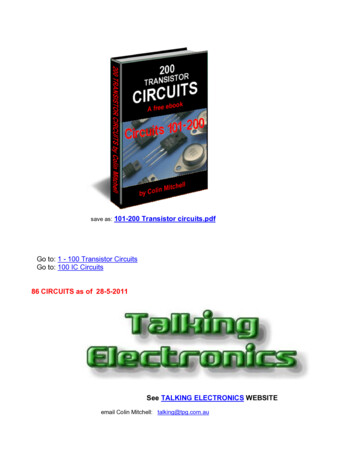
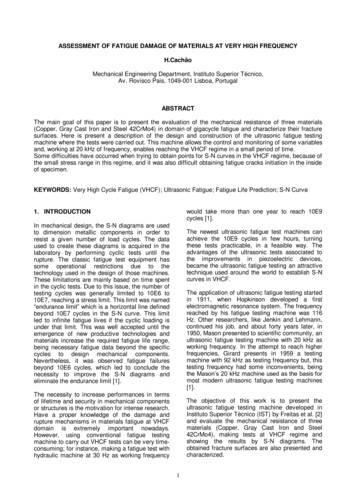
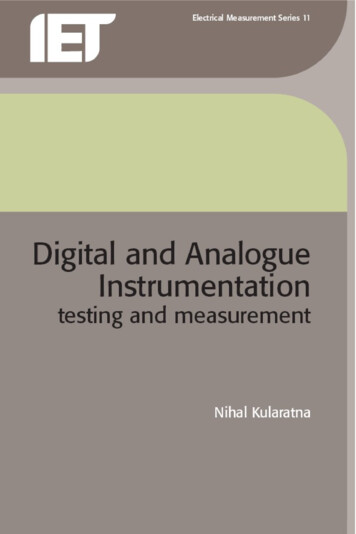
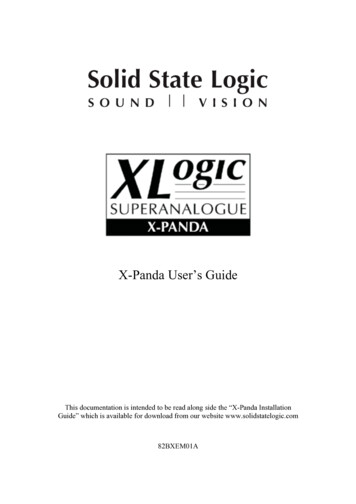
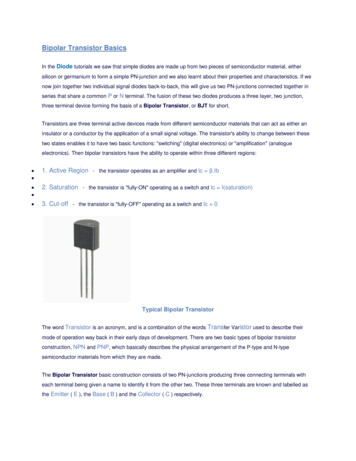


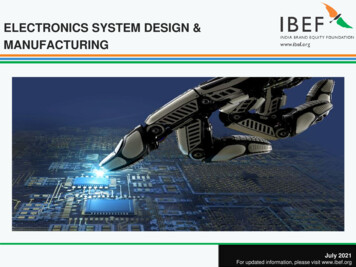
![History of Electronics electricity [Read-Only]](/img/18/history-20of-20electronics-20-20electricity.jpg)
